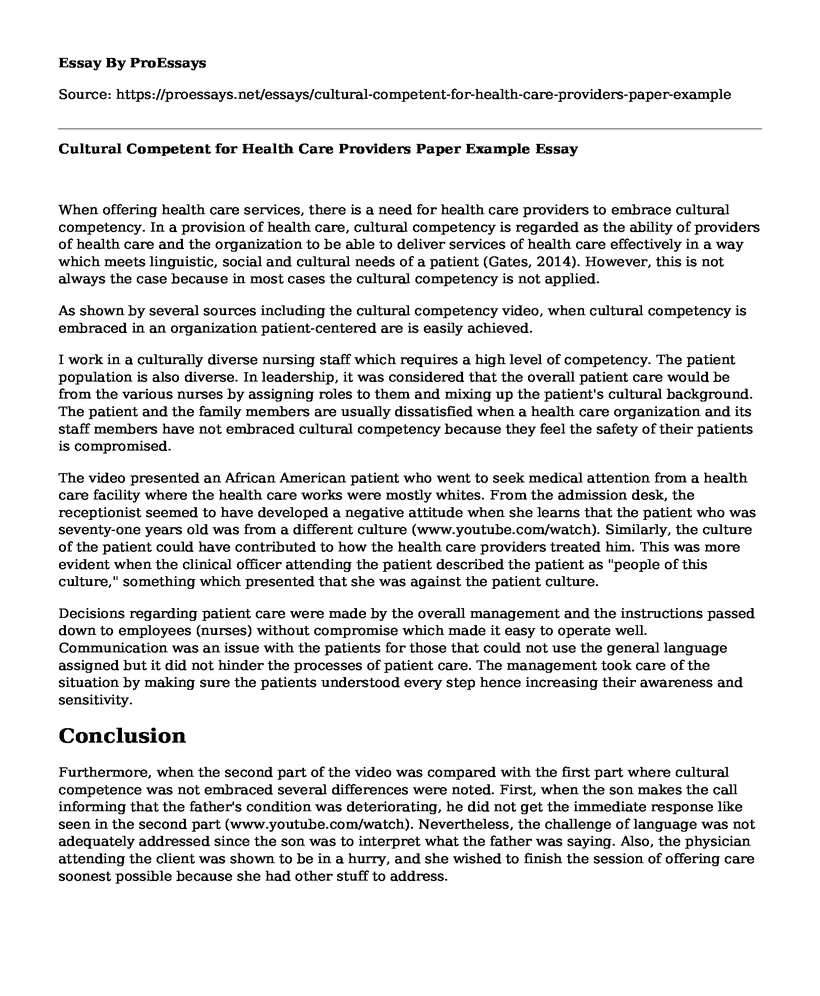When offering health care services, there is a need for health care providers to embrace cultural competency. In a provision of health care, cultural competency is regarded as the ability of providers of health care and the organization to be able to deliver services of health care effectively in a way which meets linguistic, social and cultural needs of a patient (Gates, 2014). However, this is not always the case because in most cases the cultural competency is not applied.
As shown by several sources including the cultural competency video, when cultural competency is embraced in an organization patient-centered are is easily achieved.
I work in a culturally diverse nursing staff which requires a high level of competency. The patient population is also diverse. In leadership, it was considered that the overall patient care would be from the various nurses by assigning roles to them and mixing up the patient's cultural background. The patient and the family members are usually dissatisfied when a health care organization and its staff members have not embraced cultural competency because they feel the safety of their patients is compromised.
The video presented an African American patient who went to seek medical attention from a health care facility where the health care works were mostly whites. From the admission desk, the receptionist seemed to have developed a negative attitude when she learns that the patient who was seventy-one years old was from a different culture (www.youtube.com/watch). Similarly, the culture of the patient could have contributed to how the health care providers treated him. This was more evident when the clinical officer attending the patient described the patient as "people of this culture," something which presented that she was against the patient culture.
Decisions regarding patient care were made by the overall management and the instructions passed down to employees (nurses) without compromise which made it easy to operate well. Communication was an issue with the patients for those that could not use the general language assigned but it did not hinder the processes of patient care. The management took care of the situation by making sure the patients understood every step hence increasing their awareness and sensitivity.
Conclusion
Furthermore, when the second part of the video was compared with the first part where cultural competence was not embraced several differences were noted. First, when the son makes the call informing that the father's condition was deteriorating, he did not get the immediate response like seen in the second part (www.youtube.com/watch). Nevertheless, the challenge of language was not adequately addressed since the son was to interpret what the father was saying. Also, the physician attending the client was shown to be in a hurry, and she wished to finish the session of offering care soonest possible because she had other stuff to address.
References
Gates, A., Rudowitz, R., & Guyer, J. (2014). An overview of delivery system reform incentive payment (DSRIP) waivers. Kaiser Commission on Medicaid and the Uninsured Issue Brief. files. kff. Org/attachment/an-overview-of-dsrip.
Cite this page
Cultural Competent for Health Care Providers Paper Example. (2022, Dec 05). Retrieved from https://proessays.net/essays/cultural-competent-for-health-care-providers-paper-example
If you are the original author of this essay and no longer wish to have it published on the ProEssays website, please click below to request its removal:
- Cost Management and Strategic Decision Making
- Application Example: Job Application as a Project Manager
- Nursing Essay Sample: Nurse-driven Catheter
- Ron Ventura: Case Study with Report Writing
- Contemporary Nursing and Issues Social Issues Paper Example
- Looking for the Interviewer HR Paper Example
- Essay Sample on Caring For Vulnerable Kids: Enhancing Lives in Hospital Settings







